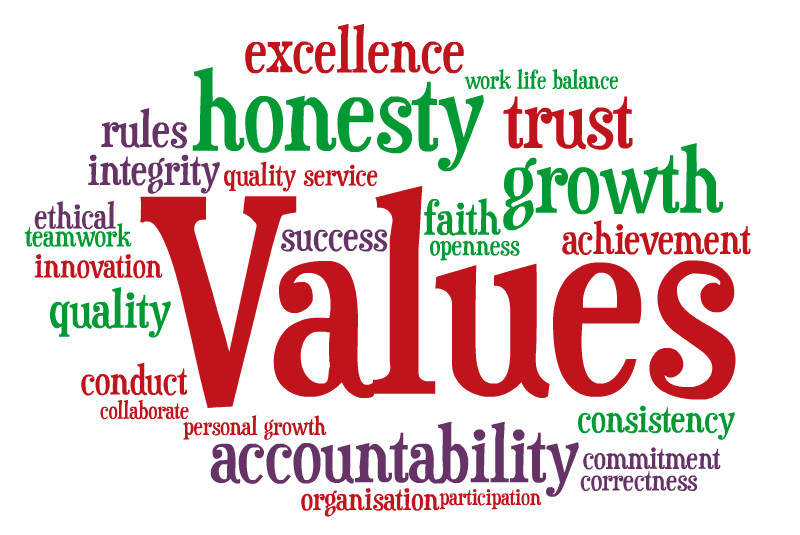
How your values and identity can sabotage your leadership
Back in October I wrote a blog about five common problems leaders bring to coaching and what to do about them. To recap they are:
- Striving and a lack of joy in life
- Working in a power/toxic culture including being bullied by a more senior manager or by peers
- Making decisions when there is an inner conflict about what to do
- Believing that being good at your job is what gets you to the top
- Self confidence.
This post is about how leaders can make decisions when there is an inner conflict about what to do.
There are many reasons that leaders prevaricate on complex decisions but I am going to focus on the role of values and identity.
You will no doubt, have come across advice exhorting you to refer to your values when you need to make an important decision. What do you stand for? What does your gut instinct suggest is the right way forward? What values are important to you?
But I have seen how sometimes your values can get in the way – which is quite a controversial statement! I am not advocating that leaders dump their values when they clash their your self-interest. Problems emerge, however, when values are based on an outdated identity rooted in your ‘adapted child’. Identity then becomes a form of decision anchor. Decision anchors are a well-known form of cognitive bias where we add unjustifiable weight to the first piece of information we come across. Identity is often constructed from the first pieces of information we come across in our lives – childhood experience.
Let’s look at an example.
Sam is having to make an important decision about redundancies. His company is going through tough times and the SMT have decided that they need to let go of about 10% of their staff.
Sam, who is in charge of a department of approximately 300 people worldwide, is strongly conflicted about the decision and how it should be made. Whenever he comes to reflecting on how to make the decision, he finds himself arguing with himself – he just doesn’t agree with the decision and feels there are other options the SMT have not considered. This is causing him to argue with his boss and prevaricate about the redundancies.
As a coach with some psychotherapeutic training, it is not my job to decide on the rightness of the decision. My role is to help Sam unpack why he is finding it so difficult to make a decision about how he should respond. His prevarication is causing his boss to lose trust in him and his people to wonder what is going to happen to them.
When working with Sam, we discover that he has strong values and emotions when it comes to disappointing people or, as he would call it, ‘harming’ others. Over the next few sessions we also find out that, as a child, Sam lost his father at an early age. As a result, he took on the mantle of ‘the man of the house’ which he interpreted as looking after his siblings and making sure they were safe and did not come to any harm. If he was unable to do this for any reason, he experienced deep feelings of failure and worthlessness. He had come to identify himself as the ‘responsible carer’, with values rooted in kindness, caring and helping others.
These values had worked well for him as the company expanded. He had highly motivated teams, who felt trusted and respected, and Sam was regarded as a good leader of people. However, in this new context, his learned values and patterns of behaviour around who he was and what he stood for, were getting in the way.
As we worked together, Sam realised that he was drawing on the values and identity that had worked well for him as a child but were now inhibiting him from responding appropriately to a more challenging situation. Moreover, he was ‘rationalising’ (which is a defence mechanism). He was arguing against the decision using logical arguments but what was really driving his behaviour was a fear of failing to protect his people and of living according to his ‘values’. But in this case his values needed updating – he was no longer the older brother looking after his siblings and ensuring they did not come to harm. When looking at the situation more objectively, as a business leader, he could see the reasons behind SMT’s decision. He realised that he would have to make some of his staff redundant, but, drawing on his ‘caring’ values he also advocated that the company put in place a programme to support the staff involved.
This may sound an unlikely scenario but it is extremely common. Sometimes the personality,values and identity that we have constructed at a young age and under difficult circumstances gets in the way of great leadership. This is why many eastern philosophical traditions regard the ‘personality’ or ‘identity’ as a block to getting in touch with who we truly are. They see the personality as a ‘construction’ and a ‘narrative’ that limits our potential. I have noticed this a lot in my coaching with clients.

Values can sometimes get in the way of great decision making.
Here’s another example.
Gemma was aiming for her next promotion which would have put her onto the executive board. But she had been told for the past two years that she was not ready. Her boss simply told her that she lacked ‘gravitas’ but couldn’t really explain what she meant by this term. “You know it when you see it”, was her answer.
The Board and the level below, which included Gemma, had scheduled a leadership retreat where they would talk about strategy, competition and the significant changes that were taking place in their markets. Gemma had expertise in this area. Furthermore, she had strong views about how the company might respond. She wanted to have the opportunity to put her views forward but, from experience, she knew that the Board tended to dominate and focused more on top down communication. She would have liked to have asked her boss for an opportunity to present to the Board before the retreat but she felt that she would be dismissed and told that she was not senior enough to engage in this debate. So she kept quiet. She felt frustrated and under-utilised as well as not valued. She really wanted to approach her boss but didn’t want to alienate her by suggesting that she knew better than the Board – she wasn’t sure what to do.
Gemma came to me and we started to explore her feelings and reactions around her dilemma. She knew she could make a big difference but her ‘softly, softly’ approach was not working. She was being ignored. So we started exploring her beliefs and feelings around the term ‘gravitas’ and also about how she went about trying to influence people. We came to the conclusion that Gemma did not really like the idea of ‘power’. She viewed ‘power’ as negative and as an aggressive and manipulative way of getting people to do what you want. She was not that kind of person, she told me. This is an extremely common response!
As we went deeper into her feelings and beliefs, it emerged that, as a child, Gemma was always being told to listen to others. Her parents, one of whom was a priest and the other a counsellor, told her that listening was the most important way of building relationships of trust with people. Occasionally, when she did express her views quite forcibly she was told not to be so self-opinionated or even ‘domineering’. So Gemma learned that in order to be accepted, she had to apply ‘soft’ power or influence. She articulated this in values such as listening, coaching and supporting others. She tried to get people on side and ‘woo’ them. Any attempt to be assertive or to put down boundaries was considered rude and unacceptable.
This meant that Gemma became very good at influencing people using soft skills but when it came to being assertive, Gemma found it very difficult. She framed any kind of ‘push’ based influencing styles (telling, explaining, forcibly persuading, insisting and directing) as authoritarian and oppressive.
Again, like Sam, this had worked well in her career so far and Gemma was well-liked. But at senior levels she found many of her peers and definitely her bosses were more direct, assertive and succinct, particularly when communicating with each other.
So I asked her to observe the behaviours and body language of those bosses and peers who seemed to demonstrate gravitas or a ‘powerful confidence’ as we termed it, which helped to reframe her values. She noticed that they did not use assertive styles all the time – when necessary they could influence more subtly – but they did use them quite regularly and, surprisingly, often gained commitment this way. She noticed this worked well either when there was not a lot of time and a decision had to be made quickly or, if everyone had had their say and there was still disagreement, someone had to make a decision. In this case, a boss being assertive and making a decision caused relief in the team as everyone could then move on.
Gemma slowly came to understand what her boss meant by gravitas – a mixture of confidence in one’s own decisions and a willingness to communicate directly, convincingly and succinctly. This was not domineering others – as she had framed it through the lens of her values. It was providing direction, being courageous and being willing to be accountable for her decisions.
With my help, Gemma started experimenting with more assertive strategies. The first thing we practised was to ask for half an hour to present some ideas to the Board which would help them get buy in and commitment from the staff on the leadership retreat. We practised body language, appearance, voice strategies and other aspects of non verbal communication. She got her half hour and made a significant impact on the Board’s thinking.
In order to grow as a leader, we sometimes have to ‘unlearn’ certain beliefs, attitudes, feelings and behaviours (values and identity). Occasionally, our values can be rooted in childhood learning and need updating. A lot of leadership development idealises ‘values’ without really questioning where they come from or if they are appropriate for our current situations. Unlearning is rarely about completely rejecting values but it does involve updating them. This can often entail being courageous enough to question assumptions about values that we may have dismissed or rejected in the past – and in my own experience, this often involves questioning our attitudes around ‘power’.
My view is that power is like any kind of skill – it can be used for harm or for good. It is not intrinsically ‘bad’ and what we need right now in the world – both in business and in politics – are more people prepared to understand and accrue power in order to do good. In other words: Responsible Leadership!
So if you find that maybe you are sabotaging your own leadership by anchoring yourself to past patterns that no longer work for you, try this exercise. But only attempt it, if you feel that you would like to overcome past patterns and you feel strong enough to look into this space. It does not work if you are feeling overwhelmed, vulnerable or lacking in confidence. You might need a different kind of help if this describes your situation.
This is not a one-off exercise. Once you have completed it for the first time, you will adjust it and work on it until you feel satisfied that you have identified some kind of truth – an ‘ah ha’ moment, perhaps.
- Take some time out to focus on this exercise. I would recommend at least 20 minutes to start with.
- Do some slow breathing exercises to relax your body and mind.
- Reflect on the situation where you feel an inner conflict, where you feel pulled in two or more directions. Simply bring it to mind and observe it without judgement.
- See if you can identify two or more voices or what we call ‘parts’ or ‘sub-personalities’ telling you different things e.g. a risk-averse sub personality that tells you to carry on doing the same as you have always done and a more growth orientated sub personality telling you to change some aspect of your approach.
- Take each of the sub personalities and see if you can identify patterns that feel natural and comfortable to you but which don’t seem to be working in this situation. Tune into your body. Allow your body to direct your attention to where any tension or discomfort arises.
- Can you trace any patterns back to their source – whether going back to childhood or a later time in your life. They will often be born out of challenging circumstances where you had to learn how to survive. Again, allow your body to lead the way. Allow memories to emerge that may have some relevance to your situation.
- Now complete this paragraph with your initial insights:
- My pattern has been to…..
- This served me in the past because….
- It is not currently serving me because….
- In the future I will change the pattern by…..
Using Sam as an example be might write:
My pattern has been to look after and care for people.
This has served me in the past because it has enabled me to be a great manager and leader of people. It has helped me to earn trust and gain respect from my teams.
It is currently not serving me because my need to look after people is preventing me from executing a decision that is vital for the business and will protect the future careers of the employees.
In the future I will change the pattern by acknowledging that I need to balance the needs of the business whilst also supporting people who may be negatively affected by my decisions.
So next time you find yourself in a position of being unable to make a decision, it may be that your values and sense of identity are getting in the way. If you’d like an initial chat to explore how I might be able to help you in this, or a similar situation, please contact me via my email Karen@karenblakeley.com or mobile: 07977 857064.
N.B. All examples are representative of my work and not related to specific clients.

